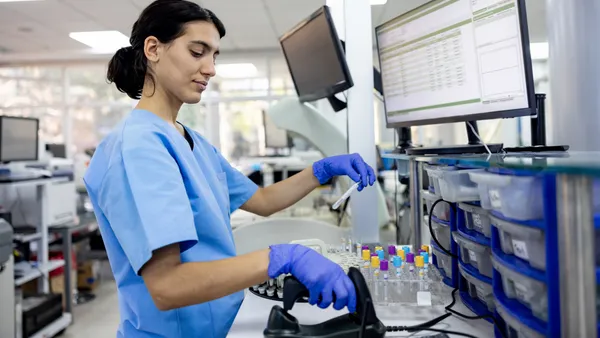Dive Brief:
- A test that combines a biomarker measurement with a computerized neurological assessment to aid in the diagnosis and prognosis of mild traumatic brain injury (TBI) has received FDA's breakthrough device designation.
- The BrainBox TBI test, intended for point-of-care or clinical laboratory settings, uses a panel of in-vitro diagnostic serum measurements that includes the biomarkers Glial Fibrillary Acidic Protein (GFAP), Neuron Specific Enolase (NSE), Neurogranin (NRGN) and others.
- The developer, BrainBox Solutions, also announced it is initiating a pivotal trial of the device to support regulatory filings for U.S. and international marketing approval. The study is expected to take 18 to 20 months to complete.
Dive Insight:
BrainBox is looking to stand out in an area of medtech that is drawing considerable interest and investment to address the rising incidence of traumatic brain injury. While other companies have focused their efforts on either an immunoassay or a neurological assessment, BrainBox says it will have the first diagnostic test and prognosis tool that will generate a single score from its components to measure the severity of the injury and guide treatment.
The artificial intelligence-enabled test is intended for patients 18 years or older in conjunction with treatment by a hospital emergency department or urgent care center. The device's panel of blood biomarkers can be read in a few minutes on a point-of-care instrument or standard laboratory system.
FDA has evaluated a slew of new diagnostic options for TBI in the past year alone. In March, the agency qualified the first biomarker test for medical device developers to use in identifying patients for enrollment in TBI studies. The OsiriX CDE test was submitted by the TBI Endpoints Development Initiative, a program supported by the Department of Defense.
In February, FDA awarded a breakthrough designation to BioDirection's Tbit platform that uses a sensor to measure protein biomarkers released into the bloodstream after a head trauma. In the same month, it granted breakthrough status to SyncThink's Eye-Sync device that employs a headset with infrared cameras to track eye movement and gather data to aid in diagnosis.
The agency granted a De Novo clearance in January to Oculogica's EyeBox, which uses eye movement data to measure cranial nerve function to gauge the presence and severity of a brain injury. In October, RightEye received 510(k) clearance for a vision screening system that tracks eye movements and correlates them to health conditions including concussion.
FDA also is on the lookout for companies illegally marketing devices to assess or manage brain injuries and has warned manufacturers of unregulated devices to remove unsubstantiated claims.
BrainBox has received initial funding from BioVentures Investors, as well as grant funding from the NFL-GE Head Health Challenge, Virginia Catalyst and National Institutes of Health. The company’s pivotal trial, called HeadSMART II (HEAD injury Serum markers and Multi-modalities for Assessing Response to Trauma), will enroll patients in hospital emergency rooms and urgent care centers.
Mild TBI, also known as concussion, accounts for 75% of brain injury cases. Falls are the No. 1 cause of traumatic brain injury, followed by impact with an object and motor vehicle crashes, according to the Centers for Disease Control and Prevention (CDC).
Sports-related concussions have emerged as a major health concern in young athletes over the past two decades. Emergency department visits for sports- and recreation-related injuries diagnosed as concussion or TBI more than doubled in children between 2001 and 2012, CDC said.










